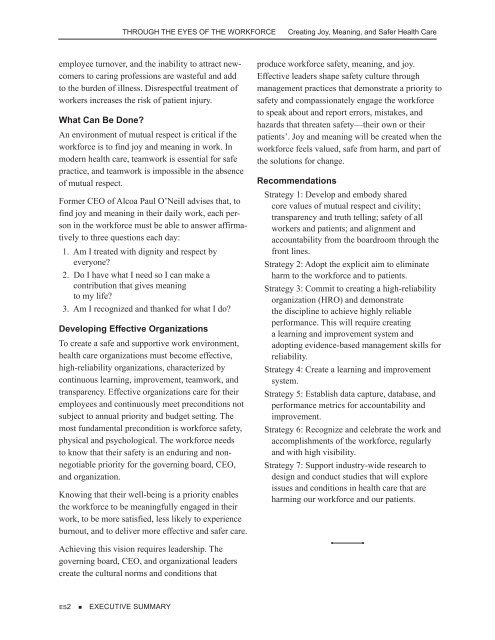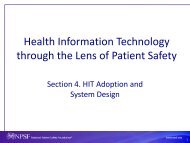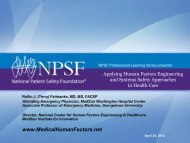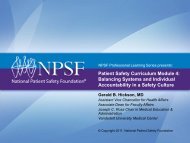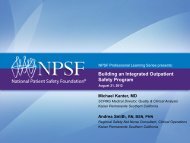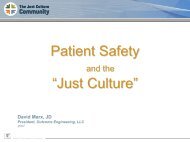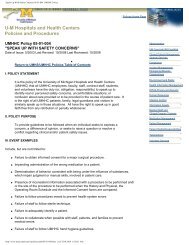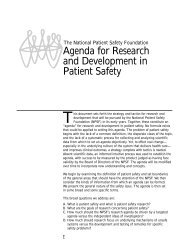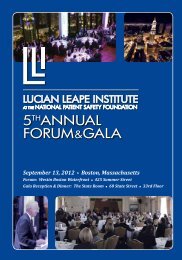Through The eyes of The Workforce - National Patient Safety ...
Through The eyes of The Workforce - National Patient Safety ...
Through The eyes of The Workforce - National Patient Safety ...
You also want an ePaper? Increase the reach of your titles
YUMPU automatically turns print PDFs into web optimized ePapers that Google loves.
THROUGH THE EYES OF THE WORKFORCECreating Joy, Meaning, and Safer Health Careemployee turnover, and the inability to attract newcomersto caring pr<strong>of</strong>essions are wasteful and addto the burden <strong>of</strong> illness. Disrespectful treatment <strong>of</strong>workers increases the risk <strong>of</strong> patient injury.What Can Be Done?An environment <strong>of</strong> mutual respect is critical if theworkforce is to find joy and meaning in work. Inmodern health care, teamwork is essential for safepractice, and teamwork is impossible in the absence<strong>of</strong> mutual respect.Former CEO <strong>of</strong> Alcoa Paul O’Neill advises that, t<strong>of</strong>ind joy and meaning in their daily work, each personin the workforce must be able to answer affirmativelyto three questions each day:1. Am I treated with dignity and respect byeveryone?2. Do I have what I need so I can make acontribution that gives meaningto my life?3. Am I recognized and thanked for what I do?Developing Effective OrganizationsTo create a safe and supportive work environment,health care organizations must become effective,high-reliability organizations, characterized bycontinuous learning, improvement, teamwork, andtransparency. Effective organizations care for theiremployees and continuously meet preconditions notsubject to annual priority and budget setting. <strong>The</strong>most fundamental precondition is workforce safety,physical and psychological. <strong>The</strong> workforce needsto know that their safety is an enduring and nonnegotiablepriority for the governing board, CEO,and organization.Knowing that their well-being is a priority enablesthe workforce to be meaningfully engaged in theirwork, to be more satisfied, less likely to experienceburnout, and to deliver more effective and safer care.produce workforce safety, meaning, and joy.Effective leaders shape safety culture throughmanagement practices that demonstrate a priority tosafety and compassionately engage the workforceto speak about and report errors, mistakes, andhazards that threaten safety—their own or theirpatients’. Joy and meaning will be created when theworkforce feels valued, safe from harm, and part <strong>of</strong>the solutions for change.RecommendationsStrategy 1: Develop and embody sharedcore values <strong>of</strong> mutual respect and civility;transparency and truth telling; safety <strong>of</strong> allworkers and patients; and alignment andaccountability from the boardroom through thefront lines.Strategy 2: Adopt the explicit aim to eliminateharm to the workforce and to patients.Strategy 3: Commit to creating a high-reliabilityorganization (HRO) and demonstratethe discipline to achieve highly reliableperformance. This will require creatinga learning and improvement system andadopting evidence-based management skills forreliability.Strategy 4: Create a learning and improvementsystem.Strategy 5: Establish data capture, database, andperformance metrics for accountability andimprovement.Strategy 6: Recognize and celebrate the work andaccomplishments <strong>of</strong> the workforce, regularlyand with high visibility.Strategy 7: Support industry-wide research todesign and conduct studies that will exploreissues and conditions in health care that areharming our workforce and our patients.Achieving this vision requires leadership. <strong>The</strong>governing board, CEO, and organizational leaderscreate the cultural norms and conditions thatES2 • EXECUTIVE SUMMARY


